RHS Chelsea 2025 - my favourite bits
I spent the day at RHS Chelsea wandering round, taking photos and generally looking for ideas to take away, of which there were plenty. And one garden featured an innovative toilet.... read on ...
🌱 I'm Sally Morgan, an organic gardener and botanist who loves to experiment. Here you can read about matters relating to climate change, sustainability, organic gardening, growing veg and biodiversity, helping you to become a
climate savvy gardener 🌱☀️🌧️❄️🌡️
It’s that time of year - the annual visit to RHS Chelsea and this year the sun shone and it was dry. It’s been a tricky build up to the show as we’ve had virtually no rain for the last couple of months and temperatures were more like July than May, so heaps of praise go to the many teams of workers and volunteers for keeping the plants looking at their best. It really can’t have been easy.
This year, I felt the gardens exuded a tranquil mood with lots of shade and pastel shades of blue, pink and white.
As usual, there were a few plants that seemed to appear in virtually every garden - Sicilian honey garlic (Nectaroscordum siculum, an allium) which is a real bee magnet, Verbascums of various colours, foxgloves, Cirsium rivulare (bottom left in photo), statuesque angelica and lots of umbellifer species, like cow parsley.
I like to spend time looking at the small gardens and the balcony and container gardens, rather than the headlining show gardens, as I feel there are more ideas for me to take away. I have focused on two gardens that I found utterly inspirational, plus a few other highlights.
All about carbon
I loved the small balcony and container garden titled C6, designed by Joshua Fenton. This tiny space was all about carbon, water and wildlife.
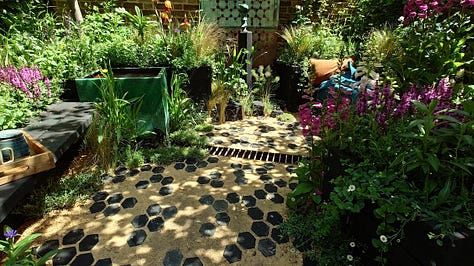
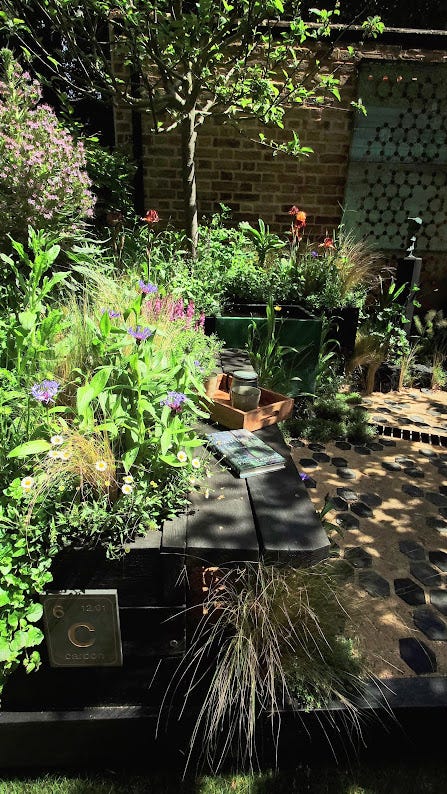

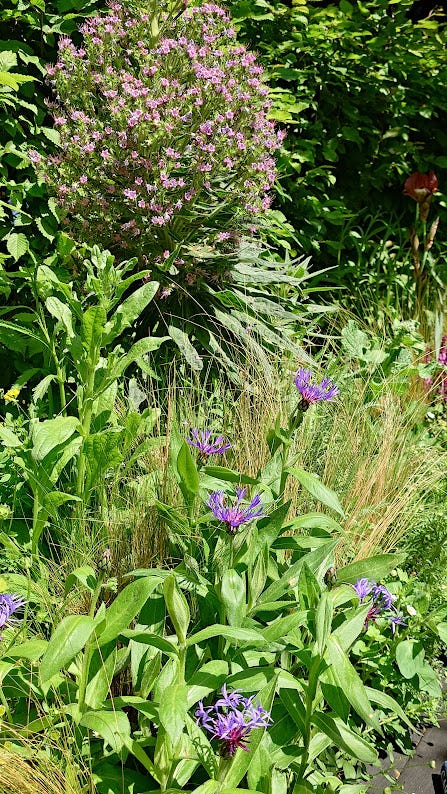
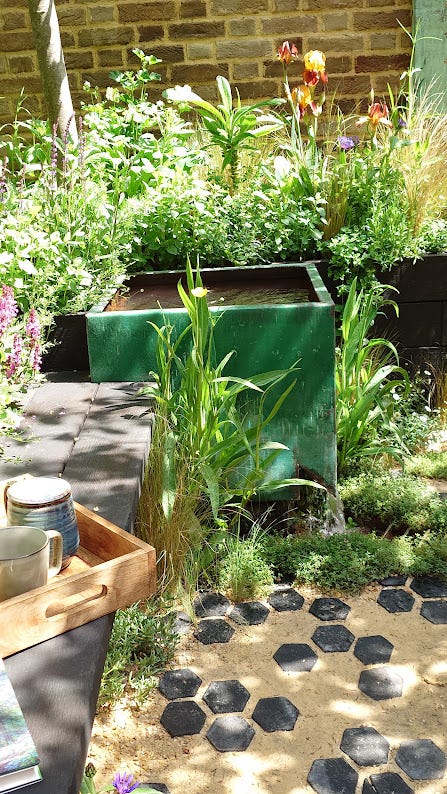
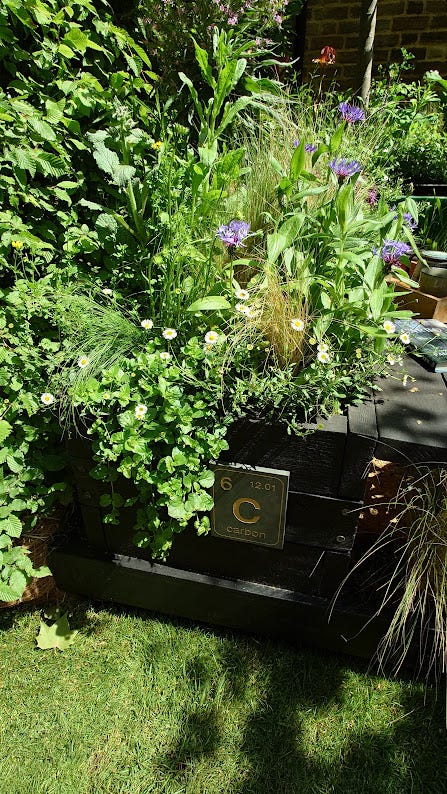
C6 refers to the atomic number of carbon, while the 12 on the sign refers to carbon's atomic mass. There were plenty of visual links to carbon in the garden, including the molecular structures (complete with double bonds) on the panel on the back wall and the hexagonal black blocks.
There was a large tank to collect rainwater and this overflowed into a rill to direct the water away from the drains and allow it to percolate into the ground. There were trees and shrubs to sequester carbon through photosynthesis, and the soil was amended with biochar, which not only locks up carbon but boosts soil health and aids water retention (as you may remember, I am a fan of biochar and have used it for years). There were lots of plants to attract insects, like the Echium, which were planted in large black containers made of charred oak to lock up carbon.
Despite the small space, this garden sequesters 1200kg+ carbon and slows down and stores 450L rainwater. Just imagine if every urban garden could do that same.....
A really clever garden with so many ideas that we could all implement in our growing spaces, whatever the size.
A garden of the future
As you would probably guess, this garden grabbed my attention. It was designed by Matthew Butler and Joshua Parker and supported by the Gates Foundation. The Gates Foundation’s mission is to create a world where every person can live a healthy productive life, but climate change is threatening the livelihoods of millions of people, especially smallholder farmers in sub-Saharan Africa and South Asia. This garden showcases many climate-smart ideas, such as climate resilient vegetables and water saving tools - and we can learn from these ideas too.
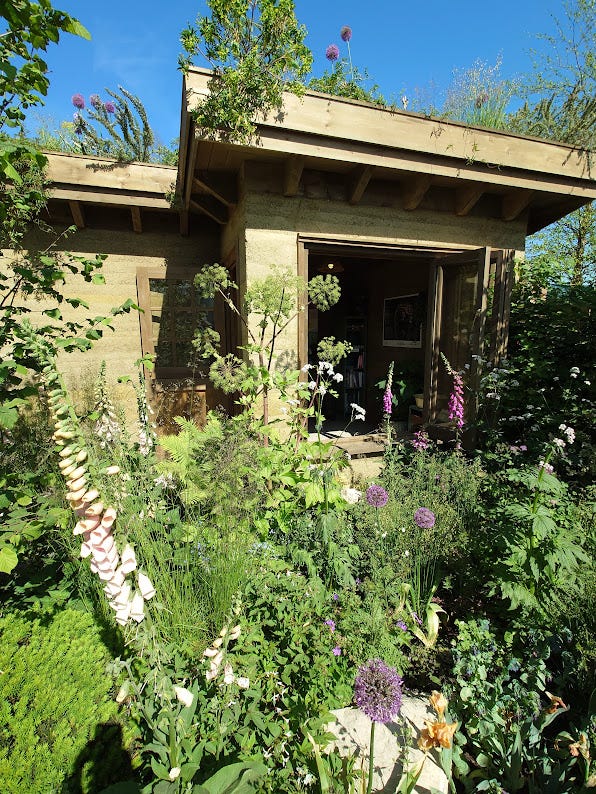
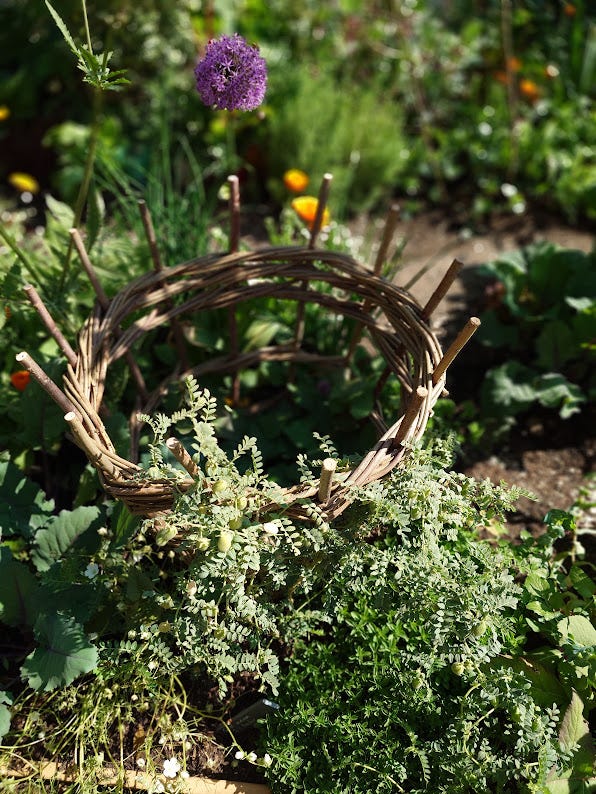
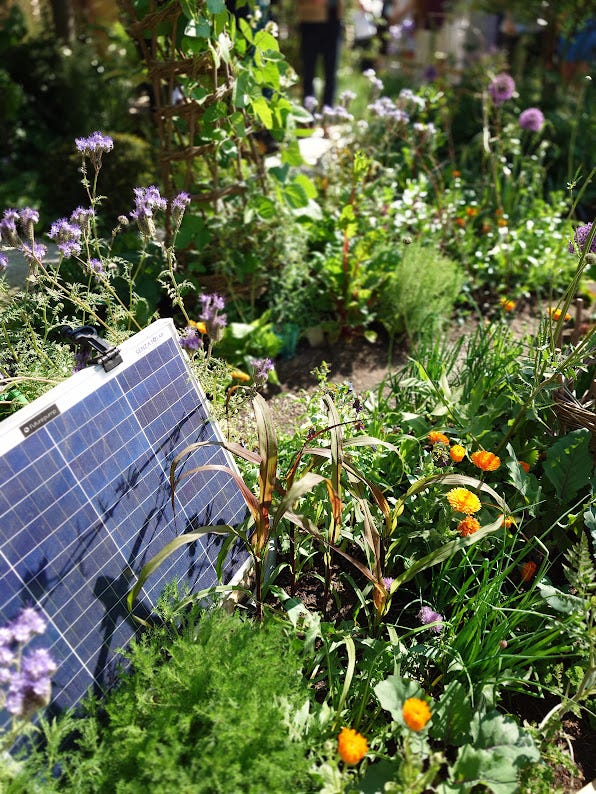
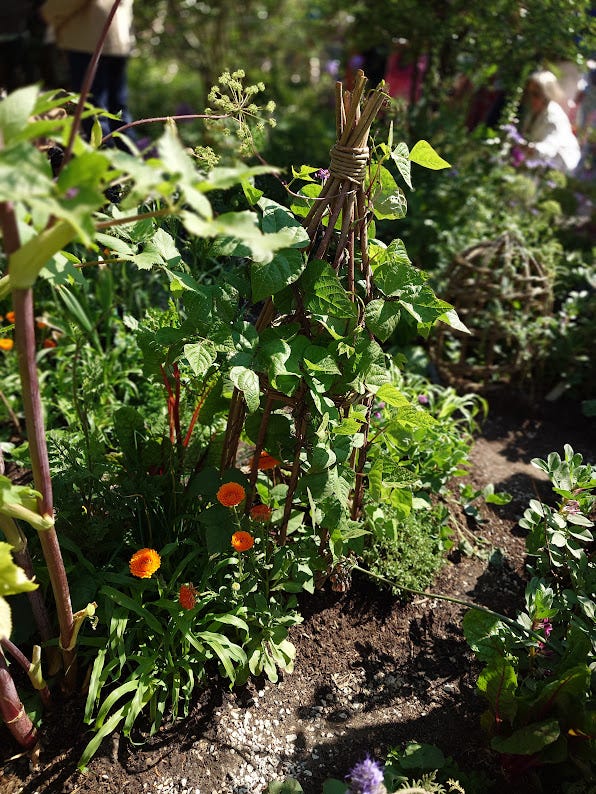
It wasn’t just the range of vegetables (chickpeas, sweet potato, pigeon pea, cow pea, sorghum, and more), the companion planting, edible hedgerow, grass roof, rainwater harvesting, solar powered irrigation system and the carbon capture, but the circular toilet. Yes, you read that correctly, there was a toilet on the garden (in the rammed earth shed) - the Cranfield Circular Toilet to be precise. And now you think I’m completely mad, I go to a flower show and get excited by a toilet.
Why is it so special - biochar!!! My goodness, two gardens at Chelsea featuring biochar.
The Cranfield Circular Toilet is a compact, self contained toilet system that uses nanotechnology to convert household waste water into clean non-potable water and pathogen-free biochar.
This is how the Gates Foundation explains the process:
When the toilet lid is closed, the bowl rotates, and waste drops into a holding tank.
A custom screw inside the toilet separates solid and liquid waste.
Solid waste moves up to a “pyrolysis unit” to create water vapour and pathogen-free char.
Char collects in the bottom of the unit for disposal.
Liquid waste is heated into a vapor that is passed through membranes to remove pathogens.
As the vapour condenses into water, it is purified using carbon filtration and then disinfected by ultraviolet light so it can be recycled for flushing.
For those of you interested in the technical stuff here’s a pdf As well as designing this innovative toilet, the team at Cranfield Uni is analysing the biochar and trialling it to discover the benefits of using it for crops.
And the plants …. I know a number of you are already growing some of these crops and I wrote about chickpeas and other ‘exotic’ crops back in January
I would love to have feedback on growing sweet potato (Ipomoea batatas), sorghum (Sorghum bicolor) and pigeon pea (Cajanus cajan) so please add any tips to the comments.
Seawilding
“Sandstone rock outcrops emerge from a saltwater pool and pebble beach, to create planting zones that range from a bog to higher, more free draining soils. A seagrass sculpture ‘flowing’ over the informal seating area connects the land-based garden with the saltwater pool, planted with seagrass, our only native flowering plant in the ocean.”
This beautiful Seawilding Garden was inspired by the landscape found at Loch Craignish on the west coast of Scotland, home to Seawilding. It shows the transition from a garden and woodland to a rock pool with seagrass.
So much attention to detail goes into building these gardens as you can see in the photos.
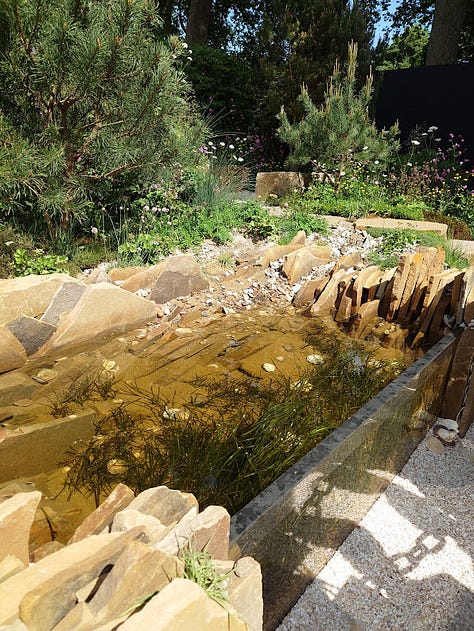
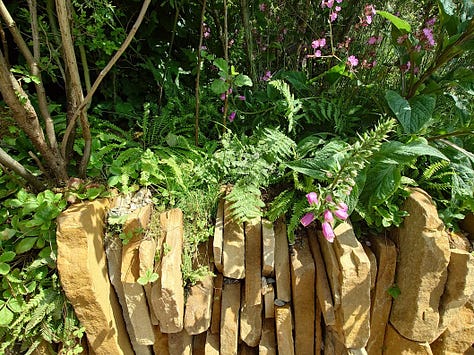
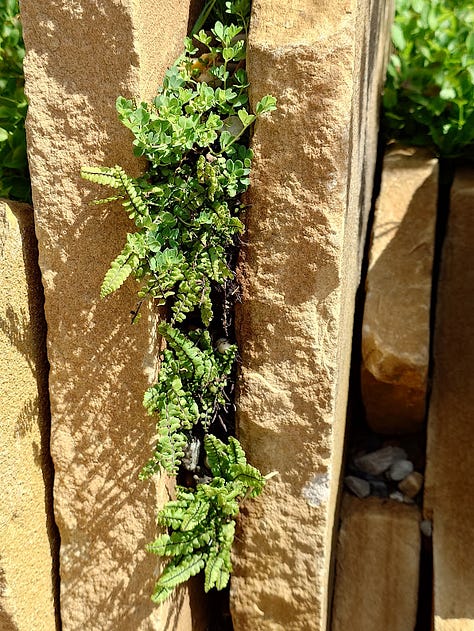
Hospitalfield Arts Garden designed by Nigel Dunnett
I have been writing about sand quite a lot over the last year, so I was delighted to see Nigel Dunnett’s Hospitalfield Arts Garden that reflects the coastal setting of the garden through the eyes of a sculptor. Nigel has tried to reflect the robust and resilient characteristics of dune vegetation, with lots of blue green grasses and colourful flowers, with a canopy of pine and Tamarix. There were lots of take away ideas for my own sand /gravel gardens here.
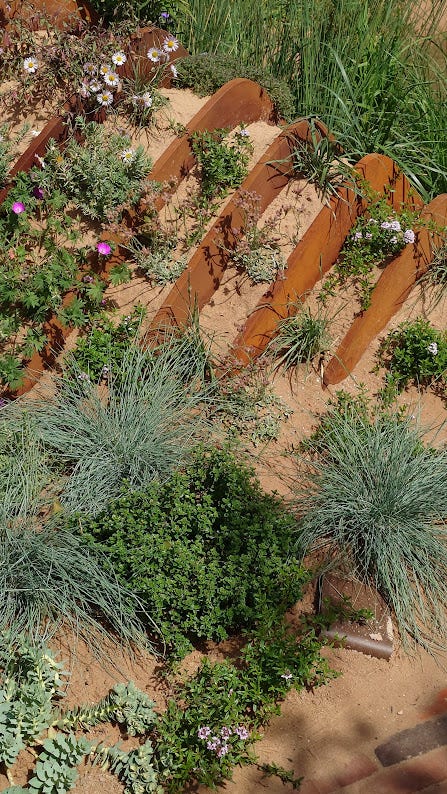
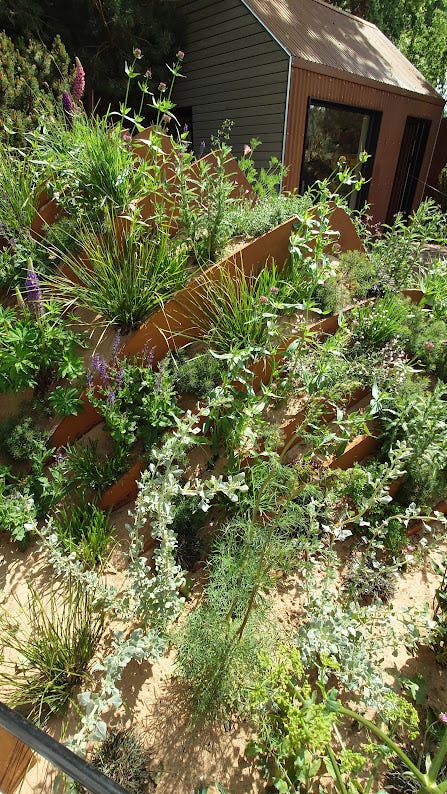
So just a few of the highlights of RHS Chelsea 2025 - I am sure many of you may have visited or will be visiting, so please share your favourite gardens and plants. I would love to include some of your highlights in next week’s post.
Happy gardening
PS If you enjoyed reading this post, please click the ‘like’ button at the bottom, it really helps make my posts more visible on the SubStack app. Thank you xxx
And finally…. I bumped into Sarah Mead of Yeo Valley Organic Gardens and as well as chatting about the show, we discussed the Yeo Valley Garden Festival thats taking place at the gardens in September. So here’s a reminder to get your tickets !!!
Note: This is a long email so if the newsletter is truncated, click on "View entire message" and you'll be able to view the entire post in your email app.






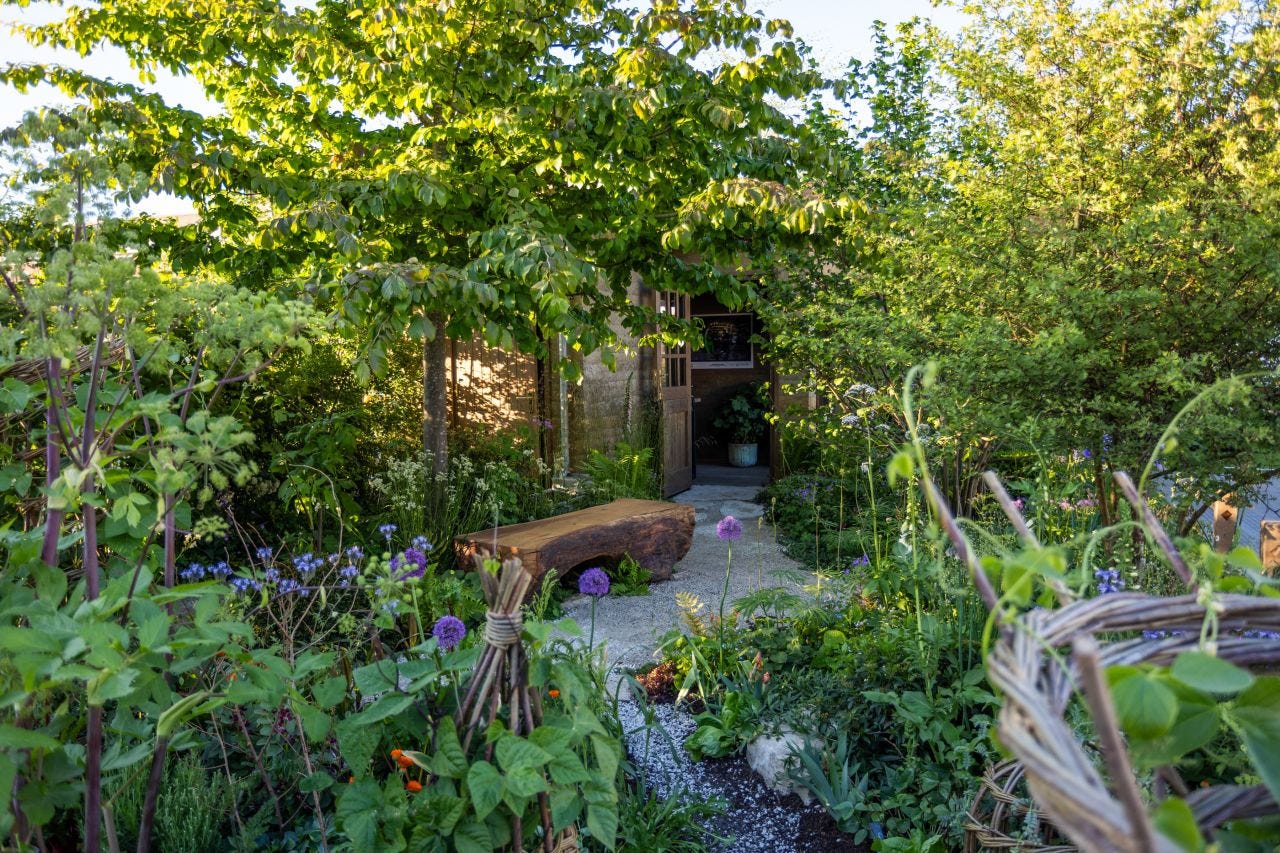




Great take aways, thanks for sharing with those of us that are a bit too far away to attend.
Loving the biochar as well (I just made a small kiln out of a paint can).
I loved all those things too Sally! But of course I did. I was lucky enough to be gifted a ticket by a company I work with. Thankful for these gardens above and the composting loo to temper the vulgarness of the show. Also found some nurseries that I Had't come across before. I've been putting bio char in my compost heaps (after activating with some of my weed water!) and I am certain plants are healthier and more resilient when sown or potted on in it.